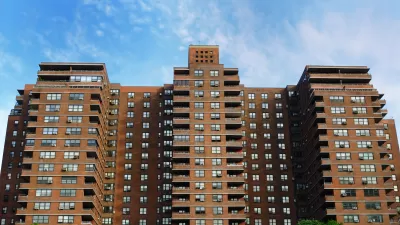There are now 227,000 individuals and families on the NYC Housing Authority's wait list for subsidized apartments, more than the city's entire public housing stock. With only 5,400 to 5,800 units available annually, the list is a dead end for most.
"It is called the Tenant Selection and Assignment Plan [PDF], but to hundreds of thousands of New Yorkers seeking a home, it is 'the list,'” writes Mireya Navarro. "Prosperous city residents may consider public housing to be a place of last resort. The waiting list indicates otherwise."
"The growth in the list — and the stories of those who struggle to move up on it to gain subsidized apartments — underscores how the city continues to face a shortage of housing for the poor and the working class."
"But," as Navarro explains, "low income alone does not determine who gets an apartment, and the waiting list is not run on a first-come-first-served basis."
"Officials favor groups of applicants in order to further policy goals. Some, like victims of domestic violence, are given priority. Others, like working families, are preferred because they can pay higher rents and also help diversify the projects so they do not segregate the poor."
"Those with a high priority can jump the line and may get an apartment in as little as three months. Others will wait years — with little if any prospect of getting off the list."
FULL STORY: 227,000 Names on List Vie for Rare Vacancies in City’s Public Housing

Trump Administration Could Effectively End Housing Voucher Program
Federal officials are eyeing major cuts to the Section 8 program that helps millions of low-income households pay rent.

Planetizen Federal Action Tracker
A weekly monitor of how Trump’s orders and actions are impacting planners and planning in America.

Ken Jennings Launches Transit Web Series
The Jeopardy champ wants you to ride public transit.

California Invests Additional $5M in Electric School Buses
The state wants to electrify all of its school bus fleets by 2035.

Austin Launches $2M Homelessness Prevention Fund
A new grant program from the city’s Homeless Strategy Office will fund rental assistance and supportive services.

Alabama School Forestry Initiative Brings Trees to Schoolyards
Trees can improve physical and mental health for students and commnity members.
Urban Design for Planners 1: Software Tools
This six-course series explores essential urban design concepts using open source software and equips planners with the tools they need to participate fully in the urban design process.
Planning for Universal Design
Learn the tools for implementing Universal Design in planning regulations.
Ada County Highway District
Clanton & Associates, Inc.
Jessamine County Fiscal Court
Institute for Housing and Urban Development Studies (IHS)
City of Grandview
Harvard GSD Executive Education
Toledo-Lucas County Plan Commissions
Salt Lake City
NYU Wagner Graduate School of Public Service




























